Astrochemistry of transition metals? The selected cases of [FeN]+, [FeNH]+ and [(CO)2FeN]+: pathways toward CH3NH2 and HNCO†
Abstract
Transition metals (TMs) are proposed to play a role in astrophysical environments in both gas and solid state astrochemistry by co-determining the homogeneous/heterogeneous chemistry represented by the gas–gas and gas–dust grain interactions. Their chemistry is a function of temperature, radiation field and chemical composition/coordination sphere and as a consequence, dependent on the astrophysical object in which TMs are localized. Here five main categories of TM compounds are proposed and classified as: (a) pure bulk and clusters; (b) TM naked ions; (c) TM oxides/minerals or inorganic compounds; (d) TM–L (L = ligand) with L = (σ and/or π)-donor/acceptor species like H/H2, N/N2, CO, and H2O and (e) TM–organoligands such as Cp, PAH, and R1![[double bond, length as m-dash]](https://www.rsc.org/images/entities/char_e001.gif) ˙
˙![[double bond, length as m-dash]](https://www.rsc.org/images/entities/char_e001.gif) ˙
˙![[double bond, length as m-dash]](https://www.rsc.org/images/entities/char_e001.gif) R2. Each of the classes is correlated to their possible localization within astrophysical objects. Because of this variety coupled with their ability to modulate reactivity and regio/enantioselectivity by ligand sphere composition, TM compounds can introduce a fine organic synthesis in astrochemistry. For the selection of small TM parental compounds to be analyzed as first examples, by constraining the TMs and the second element/molecule on the basis of their cosmic abundance and mutual reactivity, Fe atoms coupled with N and CO are studied by developing the chemistry of [FeN]+, [FeNH]+ and [(CO)2FeN]+. These molecules, due to their ability to perform C–C and C–H bond activation, are able to open the pathway toward nitrogenation/amination and carbonylation of organic substrates. By considering the simplest organic substrate CH4, the parental reaction schemes (gas phase, T = 30 K): (I) [FeN]+ + CH4 + H → [Fe]+ + H3C–NH2; (II) [FeNH]+ + CH4 → [Fe]+ + H3C–NH2 and (III) [(CO)2FeN]+ + H → [FeCO]+ + HNCO are analyzed by theoretical methods (B2PLYP double hybrid functional/TZVPPP basis set). All reactions are thermodynamically favored and first step transition states can follow a minimal energy path by spin crossing, while H extraction in reaction II shows very high activation energies. The need to overcome high activation energy barriers underlines the importance of molecular activation by radiation and particle collision. TM chemistry is expected to contribute to the known synthesis of organic compounds in space leading towards a new direction in the astrochemistry field whose qualitative (type of compounds) and quantitative contributions must be unraveled.
R2. Each of the classes is correlated to their possible localization within astrophysical objects. Because of this variety coupled with their ability to modulate reactivity and regio/enantioselectivity by ligand sphere composition, TM compounds can introduce a fine organic synthesis in astrochemistry. For the selection of small TM parental compounds to be analyzed as first examples, by constraining the TMs and the second element/molecule on the basis of their cosmic abundance and mutual reactivity, Fe atoms coupled with N and CO are studied by developing the chemistry of [FeN]+, [FeNH]+ and [(CO)2FeN]+. These molecules, due to their ability to perform C–C and C–H bond activation, are able to open the pathway toward nitrogenation/amination and carbonylation of organic substrates. By considering the simplest organic substrate CH4, the parental reaction schemes (gas phase, T = 30 K): (I) [FeN]+ + CH4 + H → [Fe]+ + H3C–NH2; (II) [FeNH]+ + CH4 → [Fe]+ + H3C–NH2 and (III) [(CO)2FeN]+ + H → [FeCO]+ + HNCO are analyzed by theoretical methods (B2PLYP double hybrid functional/TZVPPP basis set). All reactions are thermodynamically favored and first step transition states can follow a minimal energy path by spin crossing, while H extraction in reaction II shows very high activation energies. The need to overcome high activation energy barriers underlines the importance of molecular activation by radiation and particle collision. TM chemistry is expected to contribute to the known synthesis of organic compounds in space leading towards a new direction in the astrochemistry field whose qualitative (type of compounds) and quantitative contributions must be unraveled.
![Graphical abstract: Astrochemistry of transition metals? The selected cases of [FeN]+, [FeNH]+ and [(CO)2FeN]+: pathways toward CH3NH2 and HNCO](/en/Image/Get?imageInfo.ImageType=GA&imageInfo.ImageIdentifier.ManuscriptID=C4CP03218G&imageInfo.ImageIdentifier.Year=2014)


 Please wait while we load your content...
Please wait while we load your content...